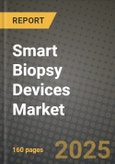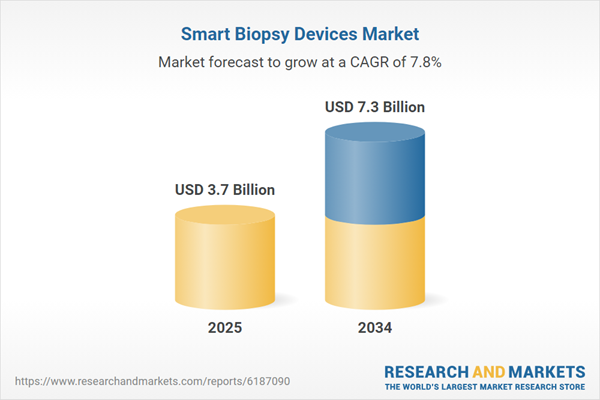The smart biopsy devices market is redefining traditional biopsy procedures through the integration of advanced imaging, AI, and real-time analytics to enable more accurate, efficient, and less invasive tissue sampling. These devices are designed to enhance diagnostic precision in oncology, dermatology, and other fields by providing real-time feedback during biopsy procedures, minimizing the need for repeat sampling and reducing patient discomfort. Smart biopsy tools often incorporate optical imaging technologies, robotics, and machine learning to help clinicians distinguish between healthy and abnormal tissue in real time. This not only improves diagnostic yield but also shortens procedure times and enhances workflow in pathology and surgical suites. With the rising global incidence of cancer and the growing emphasis on early and accurate diagnosis, healthcare providers are actively seeking smarter, technology-enabled solutions that reduce diagnostic delays and improve patient outcomes. The market is gaining traction among hospitals, diagnostic labs, and research institutions alike, supported by ongoing advancements in minimally invasive diagnostics and personalized medicine.
The smart biopsy devices market witnessed meaningful progress in product development, regulatory clearances, and clinical validation. Key manufacturers introduced devices with real-time optical coherence tomography (OCT) and AI-based pattern recognition to identify malignancies at the point of care. These systems were tested in clinical trials for breast, prostate, and skin cancers, showing promise in improving sample accuracy and reducing the number of non-diagnostic biopsies. Hospitals and specialty clinics adopted smart biopsy platforms that integrated directly with electronic medical records, allowing for streamlined data capture and automated reporting. Companies also focused on miniaturizing devices for use in outpatient settings and tele-guided diagnostics, helping improve access in rural or resource-constrained environments. Several partnerships emerged between device manufacturers and AI startups, aiming to expand diagnostic capabilities beyond imaging into predictive analytics. These developments reflect a broader industry trend toward smarter, faster, and more patient-centric diagnostic approaches, with smart biopsy tools poised to play a pivotal role in precision oncology and early disease detection.
The smart biopsy devices market is expected to advance further with the integration of robotics, cloud computing, and multi-modal imaging capabilities. Robotic-assisted biopsy tools will improve targeting precision in hard-to-access lesions, especially in organs like the liver and lung, while reducing variability between operators. AI-powered systems will evolve from passive diagnostics to active decision-support tools, helping clinicians interpret histological data in real time and prioritize high-risk cases. Remote-guided biopsy procedures using augmented reality and haptic feedback are also expected to enter pilot phases, enabling specialists to perform procedures in underserved areas through robotic interfaces. Additionally, smart biopsy tools will be embedded into integrated care pathways, linking diagnostics directly with therapeutic planning and real-time monitoring. As regulatory bodies adopt frameworks for AI-assisted diagnostics, market access will improve, but manufacturers will need to prioritize data security, clinical validation, and cost-effective scalability to ensure adoption across diverse care settings. Overall, the smart biopsy devices market will play a critical role in the evolution of diagnostic medicine - blending technology and clinical insight to make tissue sampling smarter, faster, and more precise.
Key Insights: Smart Biopsy Devices Market
- Integration of AI for Real-Time Tissue Analysis: Smart biopsy devices are increasingly using artificial intelligence to identify abnormal tissue patterns instantly, reducing reliance on external pathology labs and improving biopsy precision at the point of care.
- Adoption of Optical Imaging Technologies: Techniques like optical coherence tomography (OCT) and confocal microscopy are being embedded in biopsy tools to allow real-time visualization of tissue microstructure, enhancing accuracy and reducing false-negative results.
- Development of Robotic-Assisted Biopsy Platforms: Robotic systems are emerging to assist with guided needle placement, especially in deep or difficult-to-access areas, improving targeting accuracy and procedural safety in complex biopsies.
- Miniaturization for Outpatient and Remote Use: Compact, handheld smart biopsy devices are enabling diagnostic capabilities in outpatient settings and remote locations, improving accessibility for underserved populations and reducing the burden on centralized hospitals.
- Interoperability with EMRs and Cloud Platforms: Smart biopsy devices are now being designed to sync with electronic medical records and cloud systems, enabling seamless data capture, remote consultation, and AI-enhanced diagnostic review across healthcare networks.
- Growing Global Cancer Incidence: Rising rates of cancer across demographics are driving demand for faster, more accurate, and minimally invasive diagnostic tools, placing smart biopsy devices at the center of early detection strategies.
- Need for Precision Diagnostics in Personalized Medicine: With the shift toward personalized treatment plans, healthcare providers require biopsy tools that deliver high-quality, timely samples for genetic and molecular analysis, improving treatment outcomes.
- Increasing Investment in AI-Powered Medical Devices: Capital inflows from venture capital and government grants are accelerating innovation in AI-driven diagnostics, facilitating the development and commercialization of advanced biopsy platforms.
- Push Toward Decentralized and Remote Healthcare Models: Smart biopsy devices support the trend toward point-of-care diagnostics and remote care, helping expand access in rural and underserved regions through portable, connected solutions.
- High Cost and Complex Regulatory Approvals: The advanced technology in smart biopsy devices often results in high development and acquisition costs, while navigating regulatory approvals for AI-integrated tools remains complex and time-consuming, slowing market penetration in cost-sensitive healthcare environments.
Smart Biopsy Devices Market Segmentation
By Product
- Needle-Based Biopsy Instruments
- Procedure trays
- Localization Wires
- Other Products
By Guidance Technique
- Ultrasound-Guided Biopsy
- Stereotactic-Guided Biopsy
- Magnetic Resonance Imaging-Guided Biopsy
- Other Guidance Techniques
By Application
- Breast Cancer
- Skin Cancer
- Liver Cancer
- Prostate Cancer
- Other Applications
By End-User
- Hospitals
- Academic and Research Institutes
- Diagnostic and Imaging Centers
Key Companies Analysed
- Cardinal Health Inc
- General Electric Company
- Medtronic Plc
- Danaher Corporation
- Canon Medical Systems Corporation
- Toshiba Corporation
- Siemens Healthineers
- FUJIFILM Holdings Corporation
- Koninklijke Philips N.V.
- Becton Dickinson and Company
- Boston Scientific Corporation
- B. Braun Melsungen AG
- Olympus Corporation
- Intuitive Surgical Inc.
- Hologic Inc.
- Cook Medical Inc.
- CONMED Corporation
- Leica Biosystems
- Argon Medical Devices Inc.
- Esaote SpA
- SOMATEX Medical Technologies GmbH
- Planmed Oy
- TSK Laboratory Europe B.V.
- ZAMAR CARE
- DTR Medical Ltd.
- INRAD Inc.
- Sterylab Srl
- EndoMed Systems GmbH
Smart Biopsy Devices Market Analytics
The report employs rigorous tools, including Porter’s Five Forces, value chain mapping, and scenario-based modeling, to assess supply-demand dynamics. Cross-sector influences from parent, derived, and substitute markets are evaluated to identify risks and opportunities. Trade and pricing analytics provide an up-to-date view of international flows, including leading exporters, importers, and regional price trends.Macroeconomic indicators, policy frameworks such as carbon pricing and energy security strategies, and evolving consumer behavior are considered in forecasting scenarios. Recent deal flows, partnerships, and technology innovations are incorporated to assess their impact on future market performance.
Smart Biopsy Devices Market Competitive Intelligence
The competitive landscape is mapped through proprietary frameworks, profiling leading companies with details on business models, product portfolios, financial performance, and strategic initiatives. Key developments such as mergers & acquisitions, technology collaborations, investment inflows, and regional expansions are analyzed for their competitive impact. The report also identifies emerging players and innovative startups contributing to market disruption.Regional insights highlight the most promising investment destinations, regulatory landscapes, and evolving partnerships across energy and industrial corridors.
Countries Covered
- North America - Smart Biopsy Devices market data and outlook to 2034
- United States
- Canada
- Mexico
- Europe - Smart Biopsy Devices market data and outlook to 2034
- Germany
- United Kingdom
- France
- Italy
- Spain
- BeNeLux
- Russia
- Sweden
- Asia-Pacific - Smart Biopsy Devices market data and outlook to 2034
- China
- Japan
- India
- South Korea
- Australia
- Indonesia
- Malaysia
- Vietnam
- Middle East and Africa - Smart Biopsy Devices market data and outlook to 2034
- Saudi Arabia
- South Africa
- Iran
- UAE
- Egypt
- South and Central America - Smart Biopsy Devices market data and outlook to 2034
- Brazil
- Argentina
- Chile
- Peru
Research Methodology
This study combines primary inputs from industry experts across the Smart Biopsy Devices value chain with secondary data from associations, government publications, trade databases, and company disclosures. Proprietary modeling techniques, including data triangulation, statistical correlation, and scenario planning, are applied to deliver reliable market sizing and forecasting.Key Questions Addressed
- What is the current and forecast market size of the Smart Biopsy Devices industry at global, regional, and country levels?
- Which types, applications, and technologies present the highest growth potential?
- How are supply chains adapting to geopolitical and economic shocks?
- What role do policy frameworks, trade flows, and sustainability targets play in shaping demand?
- Who are the leading players, and how are their strategies evolving in the face of global uncertainty?
- Which regional “hotspots” and customer segments will outpace the market, and what go-to-market and partnership models best support entry and expansion?
- Where are the most investable opportunities - across technology roadmaps, sustainability-linked innovation, and M&A - and what is the best segment to invest over the next 3-5 years?
Your Key Takeaways from the Smart Biopsy Devices Market Report
- Global Smart Biopsy Devices market size and growth projections (CAGR), 2024-2034
- Impact of Russia-Ukraine, Israel-Palestine, and Hamas conflicts on Smart Biopsy Devices trade, costs, and supply chains
- Smart Biopsy Devices market size, share, and outlook across 5 regions and 27 countries, 2023-2034
- Smart Biopsy Devices market size, CAGR, and market share of key products, applications, and end-user verticals, 2023-2034
- Short- and long-term Smart Biopsy Devices market trends, drivers, restraints, and opportunities
- Porter’s Five Forces analysis, technological developments, and Smart Biopsy Devices supply chain analysis
- Smart Biopsy Devices trade analysis, Smart Biopsy Devices market price analysis, and Smart Biopsy Devices supply/demand dynamics
- Profiles of 5 leading companies - overview, key strategies, financials, and products
- Latest Smart Biopsy Devices market news and developments
Additional Support
With the purchase of this report, you will receive:- An updated PDF report and an MS Excel data workbook containing all market tables and figures for easy analysis.
- 7-day post-sale analyst support for clarifications and in-scope supplementary data, ensuring the deliverable aligns precisely with your requirements.
- Complimentary report update to incorporate the latest available data and the impact of recent market developments.
This product will be delivered within 1-3 business days.
Table of Contents
Companies Mentioned
- Cardinal Health Inc.
- General Electric Company
- Medtronic PLC
- Danaher Corporation
- Canon Medical Systems Corporation
- Toshiba Corporation
- Siemens Healthineers
- FUJIFILM Holdings Corporation
- Koninklijke Philips N.V.
- Becton Dickinson and Company
- Boston Scientific Corporation
- B. Braun Melsungen AG
- Olympus Corporation
- Intuitive Surgical Inc.
- Hologic Inc.
- Cook Medical Inc.
- CONMED Corporation
- Leica Biosystems
- Argon Medical Devices Inc.
- Esaote SpA
- SOMATEX Medical Technologies GmbH
- Planmed Oy
- TSK Laboratory Europe B.V.
- ZAMAR CARE
- DTR Medical Ltd.
- INRAD Inc.
- Sterylab Srl
- EndoMed Systems GmbH
Table Information
| Report Attribute | Details |
|---|---|
| No. of Pages | 160 |
| Published | October 2025 |
| Forecast Period | 2025 - 2034 |
| Estimated Market Value ( USD | $ 3.7 Billion |
| Forecasted Market Value ( USD | $ 7.3 Billion |
| Compound Annual Growth Rate | 7.8% |
| Regions Covered | Global |
| No. of Companies Mentioned | 28 |









